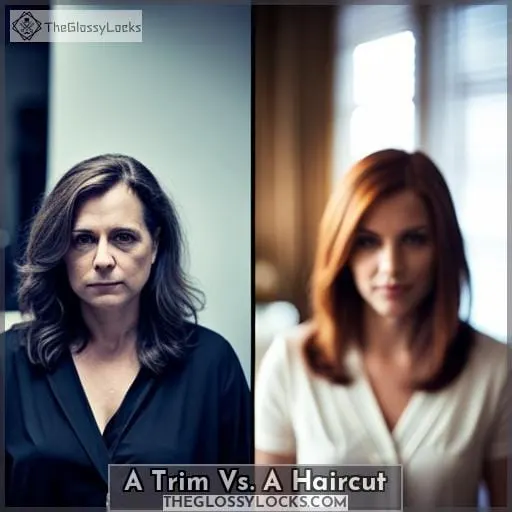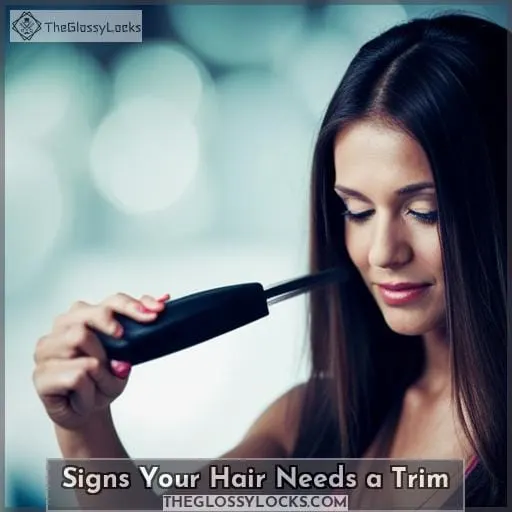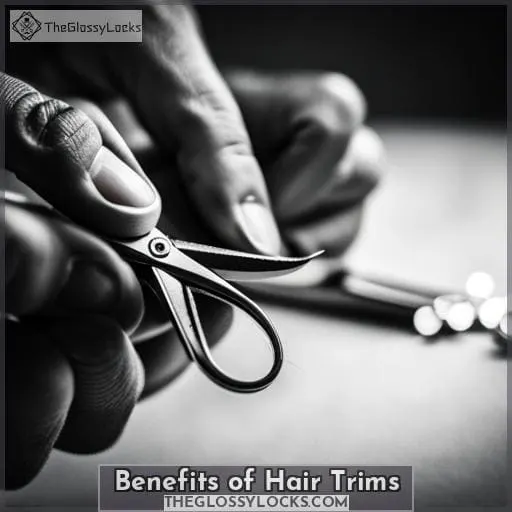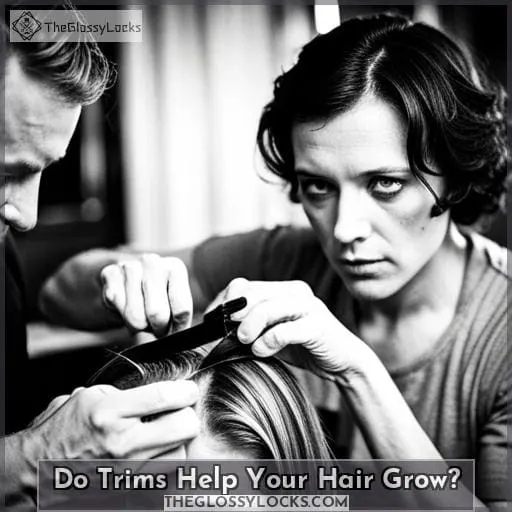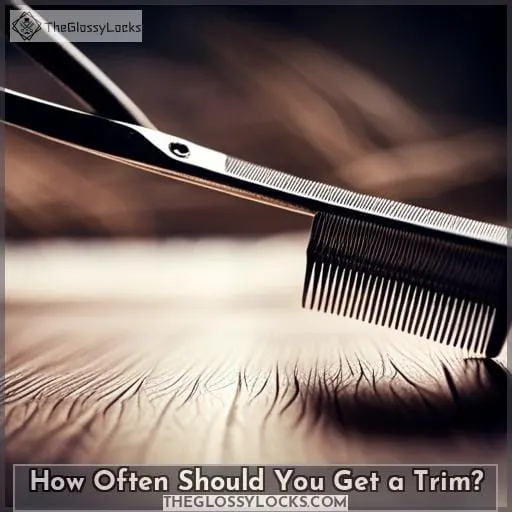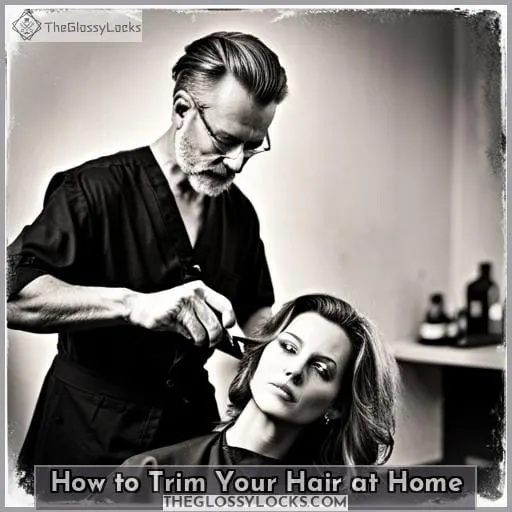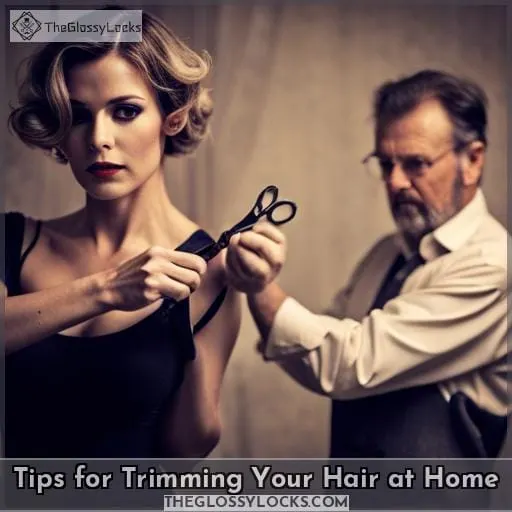This site is supported by our readers. We may earn a commission, at no cost to you, if you purchase through links.
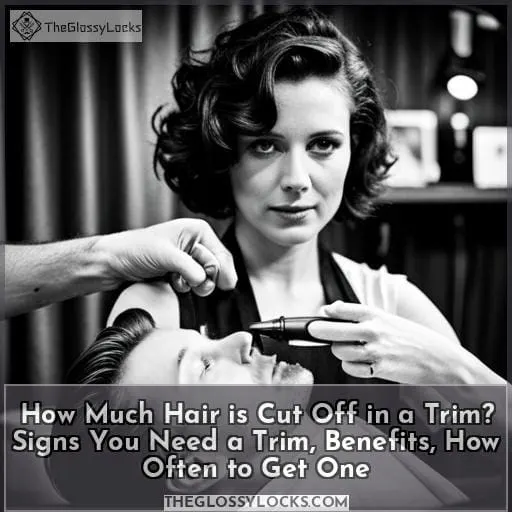 A trim is a health-related haircut that removes damaged hair from the ends of your hair. It is not the same as a haircut, which changes the overall shape of your hair. On average, a trim removes about 1/4 to 1/2 inch of hair.
A trim is a health-related haircut that removes damaged hair from the ends of your hair. It is not the same as a haircut, which changes the overall shape of your hair. On average, a trim removes about 1/4 to 1/2 inch of hair.
Table Of Contents
- Key Takeaways
- A Trim Vs. A Haircut
- Signs Your Hair Needs a Trim
- How Much Hair is Cut Off in a Trim?
- Benefits of Hair Trims
- Do Trims Help Your Hair Grow?
- How Often Should You Get a Trim?
- How to Trim Your Hair at Home
- Tips for Trimming Your Hair at Home
- When to See a Hairstylist for a Trim
- Frequently Asked Questions (FAQs)
- Conclusion
Key Takeaways
- A trim is a maintenance cut that removes split ends and damaged hair.
- The amount of hair that is cut off in a trim will vary depending on the length and thickness of your hair.
- A typical trim will remove about 1/4 to 1/2 inch of hair.
- There are a number of benefits to getting regular hair trims, including:
- Removing split ends can help to prevent further damage to your hair.
- A trim can help to improve the overall appearance of your hair, making it look healthier and more voluminous.
- A trim can help to promote hair growth.
A Trim Vs. A Haircut
A trim is a maintenance cut that removes split ends and damaged hair, whereas a haircut is a more drastic change in length or style.
The average client trims a full inch off every two months.
You can go longer between trims if your hair is healthy and strong.
Make regular trim appointments with your stylist so that your ‘do is always on point.
Signs Your Hair Needs a Trim
Signs you need a trim:
- Your hair is tangling more easily
- It’s flat and limp
- It’s stuck at the same length
- You see an increase in split ends
- You’re coming across more single-strand knots.
A trim is a maintenance cut that removes split ends and damaged hair, so getting one regularly can help keep your hair healthy and looking its best.
How Much Hair is Cut Off in a Trim?
On average, trims remove from a quarter of an inch to an inch from the ends of your hair. The amount of hair cut off during a trim can vary depending on your preferences and the severity of damage.
Here are some key points to consider:
-
Trims vs. Dusting:
A trim involves removing more length compared to dusting, which focuses on minimal cutting to remove split ends.
-
Trims vs. Layers:
While trims maintain overall length, layers involve cutting different lengths throughout the hair for added dimension.
3.Trims vs.Blunt Cut:
A blunt cut creates a straight edge across all layers while trims maintain natural shape and movement in the hair.
4.Trimes Vs.Point Cuts :
A point cut removes weight from thick or heavy sections by creating texture with angled cuts.
Remember that how much you should trim depends on factors such as your desired style, current health state and styling routine.Focus on regular trimming every 8-12 weeks for straight or wavy locks,and 6-8 weeks for curly ones,to promote healthy growth and prevent further damage.
Benefits of Hair Trims
Getting regular hair trims offers several benefits for your hair.
Trimming helps keep your hair healthy by removing damaged ends, allowing new growth to thrive.
It also leaves your strands smoother, stronger, and more manageable while preventing further damage from traveling up the shaft.
Additionally, regular trims can help promote longer hair growth by keeping split ends at bay and maintaining overall hair health.
Keeps hair healthy
Regular trims are essential for keeping your hair healthy and maintaining its overall condition.
Trims prevent split ends, remove dry ends, and make your hair stronger.
They also make your hair more manageable and help it grow faster by using hair growth oils.
Incorporating regular trims into your routine will leave you with healthier, stronger locks that are easier to style and care for.
– Removes damage
To maintain healthy hair, it’s important to remove damage during a trim.
Trimming your hair removes split ends and dry ends, preventing them from traveling upwards and causing further damage.
By removing damaged sections of the hair, trims make your hair stronger and promote healthier growth.
Additionally, getting rid of dry ends makes your hair more manageable and easier to style.
– Helps hair grow longer
If you want to achieve longer hair, getting regular trims can help. Here are the benefits of hair trims:
- Helps hair grow faster
- Prevents split ends
- Removes dead hair
- Makes hair stronger and improves overall health.
Do Trims Help Your Hair Grow?
Getting regular trims doesn’t affect how quickly your hair grows. However, trims do have a positive impact on the overall health and appearance of your hair, which in turn can help it grow longer and stronger.
When you get rid of split ends through regular trims, you prevent them from traveling up the hair shaft and causing further damage. This allows your hair to retain length as it grows without unnecessary breakage or thinning.
Trimming also helps to keep your strands thicker by removing any damaged or weak sections that may hinder growth.
Additionally, a trim promotes healthier hair by getting rid of dryness and preventing excessive frizz or tangling.
So while trims won’t directly make your hair grow faster, they contribute to its overall well-being for optimal growth potential.
How Often Should You Get a Trim?
How frequently you need a trim depends on your hair’s health, texture, and styling routine.
Here are 3 factors that affect how often you should get a trim:
- Hair type: Fine, thin hair will need to be trimmed more often than coarse, thick hair.
- Hair growth rate: Hair that grows quickly will need to be trimmed more often than hair that grows slowly.
- Desired length: If you’re trying to grow your hair long, you’ll need to trim less often than if you’re maintaining a shorter length.
If you aren’t sure how often you should get a trim, talk to your hairstylist.
How to Trim Your Hair at Home
With a few simple tools, you can trim your hair at home between salon visits by following these steps.
Here’s what you’ll need:
- A pair of sharp scissors
- A comb
- A hairdryer (optional)
Once you have your tools, follow these steps:
- Wash and condition your hair as usual.
- Blow-dry your hair until it’s completely dry.
- Part your hair into four sections: front, back, left, and right.
- Starting with the front section, use a comb to separate a small section of hair.
- Hold the section of hair taut between your fingers and trim the ends with the scissors.
- Repeat steps 4-5 for the remaining sections of hair.
When trimming your hair, it’s important to use a light touch and only trim a small amount at a time.
You can also use a layering technique to create a more natural-looking trim. To do this, start by trimming the bottom layer of your hair first. Then, work your way up, trimming each layer slightly shorter than the one before it.
With a little practice, you can easily trim your hair at home to achieve a stylish and healthy look.
Tips for Trimming Your Hair at Home
Trimming your hair at home can be a great way to save money and maintain your desired length.
- Use thinning shears to remove split ends without cutting too much hair.
- Avoid blunt ends by cutting your hair in a slight V-shape.
- Don’t cut your hair too short, as this can damage the hair and make it more prone to split ends.
When to See a Hairstylist for a Trim
If you aren’t comfortable trimming your own hair, you can see a hairstylist for a trim. A hairstylist can help you achieve the desired length and style for your hair, and they can also advise you on the best way to care for your hair type and help you prevent split ends.
Here are some signs that you may need to see a hairstylist for a trim:
- Your hair is damaged and you aren’t sure how to care for it.
- You’re trying to grow your hair long, but it isn’t growing as fast as you’d like.
- You’re unhappy with the way your hair looks or feels.
A hairstylist can help you address these issues and get your hair healthy and growing again.
Frequently Asked Questions (FAQs)
What is the difference between a trim and a haircut?
A trim is a maintenance cut that removes split ends and damaged hair, while a haircut is a more drastic change in length or style.
What are the signs that your hair needs a trim?
Your hair is telling you it needs a trim when it’s:
- Tangled more easily
- Limp
- Stuck at the same length
- Sporting more split ends.
How much hair is cut off in a trim?
On average, trims remove from a quarter of an inch to an inch from the ends of your hair.
Trims don’t change the overall shape of your hair.
What are the benefits of getting a trim?
Getting a trim keeps your hair healthy, manageable, and looking its best.
Trims remove damage before it travels upwards and destroys the rest of your hair.
How often should you get a trim?
To maintain healthy hair, it’s recommended to get a trim:
- Every 8-12 weeks for straight and wavy locks, and
- Every 6-8 weeks for curly hair.
The frequency depends on your hair’s health, texture, and styling routine.
Conclusion
A trim is a great way to keep your hair healthy and looking its best.
On average, a trim removes about 1/4 to 1/2 inch of hair.
Getting a trim every 6-8 weeks will help to prevent split ends and keep your hair growing long and strong.

